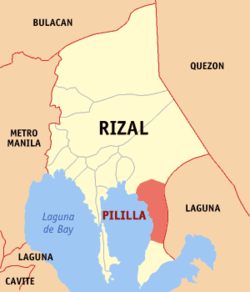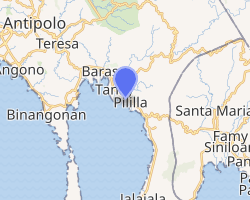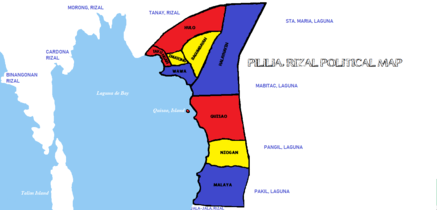Pililla, Rizal
Pililla (/pɪˈliːljə/), officially the Municipality of Pililla (Tagalog: Bayan ng Pililla), is a 1st class municipality in the province of Rizal, Philippines. According to the 2015 census, it has a population of 64,812 people.[4] It is surrounded by farms, small mountains, plains, and trees. Pililla is known as the Green Field Municipality of Rizal.
Pililla | |
|---|---|
| Municipality of Pililla | |
Welcome arch | |
 Seal | |
 Map of Rizal with Pililla highlighted | |
OpenStreetMap 
| |
.svg.png) Pililla Location within the Philippines | |
| Coordinates: 14°29′N 121°18′E | |
| Country | |
| Region | Calabarzon (Region IV-A) |
| Province | Rizal |
| District | 2nd District |
| Founded | May 5, 1583 [1] |
| Barangays | 9 (see Barangays) |
| Government | |
| • Type | Sangguniang Bayan |
| • Mayor | Dan V. Masinsin |
| • Vice Mayor | Rafael L. Carpio |
| • Congressman | Juan Fidel Felipe F. Nograles |
| • Electorate | 38,865 voters (2019) |
| Area | |
| • Total | 69.95 km2 (27.01 sq mi) |
| Population (2015 census)[4] | |
| • Total | 64,812 |
| • Density | 930/km2 (2,400/sq mi) |
| • Households | 13,057 |
| Economy | |
| • Income class | 1st municipal income class |
| • Poverty incidence | 7.98% (2015)[5] |
| • Revenue (₱) | 143,851,285.31 (2016) |
| Time zone | UTC+8 (PST) |
| ZIP code | 1910 |
| PSGC | |
| IDD : area code | +63 (0)2 |
| Climate type | tropical monsoon climate |
| Native languages | Tagalog |
Pililla has preserved some religious and non-religious traditions such as the Santa Cruzan or Flores de Mayo, wherein men and women walk all over town with their gowns. Town Fiesta during the month of July is being visited by people from the city to experience the celebrations especially the amateur shows at night. Like other towns, Pililla holds basketball league competitions for youth during summer. Pililla is also a destination for road cyclists because of its asphalted road, specifically in Sitio Bugarin in Barangay Halayhayin.
History
Pilang Munti (Pililla's pre-Hispanic name) was ruled by a leader named Salyan Maginto. His territory encompasses the modern-day jurisdiction of the municipalities of Baras, Tanay, Pililla, and Jalajala. It was referenced as “munti” in contrast to the nearby and much larger town of Pila in the province of Laguna.
Cavada, a Spanish historian, revealed that in the year 1571, the Spanish forces conquered the towns along Laguna de Bay which they called “Rinconada de Moron” and Pilang Munti was among these which surrendered to the superior force of the Spaniards. Pilang Munti was incorporated into the colonial administration of Morong, and thus, the town was called "Pilang Morong".
In 1572, the first Spanish missionary priests arrived at Pilang Morong. Since then, Christianity was spread by the Spanish priests and in 1582, Fr. Juan de Placencia and Fr. Diego de Oropesa established a “visita” barrio at Pilang Morong. The place was divided by the Spaniards into 5 “rancherias”:
- Monte Tan-ay
- Sitio Tigbi (Lulukong)
- San Diego
- Monte Yakat
- Dolo Rio (Wawa)
In 1583, Pilang Morong became an independent municipality. ”Pililla” was given as the official name of the newly formed town. The name “Pililla” arose from the diminutive rules in the Castillan language by modifying a name with “-illa” or “-illo” to indicate a smaller or younger version.
In 1599, 16 years after the town was given autonomy, the supreme government granted Pililla the authority to construct a church.
In 1600, the first church of cogon and bamboo was constructed in the Dolo Rio but this was burned and a church made of wood was constructed but this was also burned down with the whole town in 1632. Another church made of wood was built and this suffered the same fate in 1668. Two years later, the construction of the present church began. This was finished in 1673 and the edifice still stands up to the present.
As an autonomous town, Pililla encompassed several barrios including Tanay and Jalajala. Tanay separated from Pililla and became an independent town in 1606. Jalajala became a barrio of Pililla in 1676 but was separated and made an independent town in 1786. It was reincorporated as a barrio of Pililla in 1816, but 9 years later, it was once again separated from Pililla to become an independent municipality.
On December 4, 1837, an election of local officials was held in Pililla. The following towns participated in the said election: Morong, Pililla, Tanay, Baras, Jalajala and San Diego. The last town was a new town and is presumed to be either the barrio of Quisao, which has San Diego as its patron, or the barrio of Niogan.
In 1853, Pililla was separated from the province of Laguna to be incorporated into the newly created Distrito de los Montes de San Mateo. In 1857, it was given the new name Distrito Politico-Militar de Morong.
On March 10, 1861, two principales of San Diego presented to the government a request, on behalf of the residents of San Diego and the sitios of Mavia and Puang, that their territory be separated from Pililla and to create an independent town to be called Perez. Both the gobernadorcillo and the parish priest, as well as the gobernador politico-militar de Morong, favored the petition. However, it was disapproved by the Administracion Civil since the territory did not meet the pre-requisite of having at least 500 tributes, the said territory was having only 298 tributes at that time.
On July 9, 1885, the government received another petition from Cabeza de Barangay of San Diego requesting that it be made into a kind of self-governing barrio of Pililla, on account of its remoteness. On January 25, 1886, the government agreed to make San Diego into a “Visita con Teniente Absolute”, on condition that the barrio constructs the necessary public buildings. Thus, upon the fulfillment of the agreed condition, the government's approval went into effect on June 18 of that same year.
In 1896, the Katipuneros of Pililla and San Diego established their military camp at Rambo or Pabalang na Gubat.
Three years later, on August 6, 1898, Pililla was incorporated in the revolutionary government of Gen. Emilio Aguinaldo. During the existence of the Philippine Republic, San Diego became an independent town. On January 5, 1899, a fierce battle ensued between the American forces and the Filipino troops defending Pililla. The town was partially ravaged by fire and local troops had to retreat to the mountain of Tanay.
The towns of Pililla and San Diego were integrated into the newly created province of Rizal in June 1901. Two years later, the Philippine Commission, in line with its policy of economy and centralization, consolidated the towns of Pililla, San Diego and Jalajala with the seat of government in Pililla.
The first Capitan under the American regime was Regino Quitiong who was the alcalde from 1900 to 1901.
On September 20, 1907, Jalajala was separated from Pililla and became an independent municipality. Quisao, on the other hand, remained a barrio of Pililla up to the present.
In 1918, the population of Pililla was 2,776 and Quisao was 814. In 1929, the place called Longos within the jurisdiction of Pililla was cleared by the majority of the tenant population of the town of Jalajala who transferred their homes to this site and whereon they founded a new community, thus avoiding their agrarian conflict with the plantation owner of Jalajala.
On September 24, 1929, Don Ananias Vicencio, a philanthropist in public documents, donated a tract of land containing approximately 15 hectares to the families of Manuel Roxas, Leoncio Carungay and Quintin Golliden, all of Jalajala, who shall distribute and assign free of charge and to the best interest of the residents, the said lot at Longos, Barrio Quisao, Municipality of Pililla. In 1939, this land was surveyed by Engr. Quintin Gollidon who provided the layout of this new community now called Barrio Malaya.
On December 13, 1942, the town of Quisao was attacked and pillaged by "tulisanes".
During the liberation of the town on March 18, 1945, nearly 3/4 of all the houses and public buildings were either burned or destroyed by American and Filipino military bombing and shelling. The Japanese forces and Makapili fled to the mountains following the liberation of the town. The PCAU of the US Army reestablished the municipal government of Pililla on April 20, 1945 with the designation of Lucio Aquino, an active guerrilla leader, as the mayor.
Barangays

Climate
| Climate data for Pililla, Rizal | |||||||||||||
|---|---|---|---|---|---|---|---|---|---|---|---|---|---|
| Month | Jan | Feb | Mar | Apr | May | Jun | Jul | Aug | Sep | Oct | Nov | Dec | Year |
| Average high °C (°F) | 26 (79) |
27 (81) |
29 (84) |
31 (88) |
31 (88) |
30 (86) |
29 (84) |
29 (84) |
29 (84) |
29 (84) |
28 (82) |
26 (79) |
29 (84) |
| Average low °C (°F) | 22 (72) |
22 (72) |
22 (72) |
23 (73) |
24 (75) |
25 (77) |
24 (75) |
24 (75) |
24 (75) |
24 (75) |
24 (75) |
23 (73) |
23 (74) |
| Average precipitation mm (inches) | 58 (2.3) |
41 (1.6) |
32 (1.3) |
29 (1.1) |
91 (3.6) |
143 (5.6) |
181 (7.1) |
162 (6.4) |
172 (6.8) |
164 (6.5) |
113 (4.4) |
121 (4.8) |
1,307 (51.5) |
| Average rainy days | 13.4 | 9.3 | 9.1 | 9.8 | 19.1 | 22.9 | 26.6 | 24.9 | 25.0 | 21.4 | 16.5 | 16.5 | 214.5 |
| Source: Meteoblue [6] | |||||||||||||
Demographics
| Year | Pop. | ±% p.a. |
|---|---|---|
| 1903 | 2,859 | — |
| 1918 | 4,701 | +3.37% |
| 1939 | 5,461 | +0.72% |
| 1948 | 6,067 | +1.18% |
| 1960 | 9,021 | +3.36% |
| 1970 | 15,052 | +5.25% |
| 1975 | 18,985 | +4.77% |
| 1980 | 23,222 | +4.11% |
| 1990 | 32,771 | +3.51% |
| 1995 | 37,081 | +2.34% |
| 2000 | 45,275 | +4.37% |
| 2007 | 58,525 | +3.60% |
| 2015 | 64,812 | +1.28% |
| Source: Philippine Statistics Authority[4][7][8][9] | ||
In the 2015 census, the population of Pililla, Rizal, was 64,812 people,[4] with a density of 930 inhabitants per square kilometre or 2,400 inhabitants per square mile.
References
- http://www.radyoagila.com/provincial/434-years-foundation-day-ng-munisipalidad-ng-pililla-rizal-ipinagdiwang/
- "Municipality". Quezon City, Philippines: Department of the Interior and Local Government. Retrieved 31 May 2013.
- "Province: Rizal". PSGC Interactive. Quezon City, Philippines: Philippine Statistics Authority. Retrieved 12 November 2016.
- Census of Population (2015). "Region IV-A (Calabarzon)". Total Population by Province, City, Municipality and Barangay. PSA. Retrieved 20 June 2016.
- "PSA releases the 2015 Municipal and City Level Poverty Estimates". Quezon City, Philippines. Retrieved 1 January 2020.
- "Pililla: Average Temperatures and Rainfall". Meteoblue. Retrieved 11 May 2020.
- Census of Population and Housing (2010). "Region IV-A (Calabarzon)". Total Population by Province, City, Municipality and Barangay. NSO. Retrieved 29 June 2016.
- Censuses of Population (1903–2007). "Region IV-A (Calabarzon)". Table 1. Population Enumerated in Various Censuses by Province/Highly Urbanized City: 1903 to 2007. NSO.
- "Province of Rizal". Municipality Population Data. Local Water Utilities Administration Research Division. Retrieved 17 December 2016.
External links
| Wikimedia Commons has media related to Pililla, Rizal. |